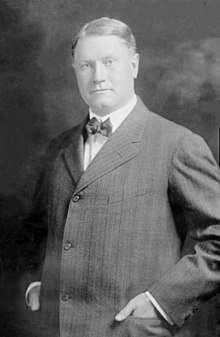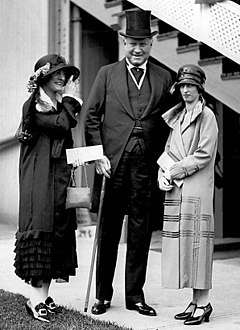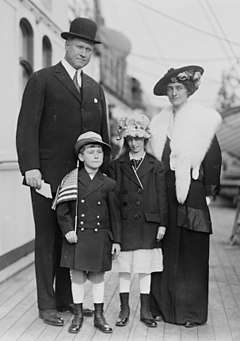Henry Worth Thornton
Sir Henry Worth Thornton, KBE (November 6, 1871 – March 14, 1933) was a businessman and president of Canadian National Railways. His parents were Henry Clay Thornton and Millamenta Comegys Worth. Henry W. Thornton married Virginia D. Blair, from a prominent Pittsburgh family, on June 20, 1901; They had two children: James Worth Thornton and Anna Blair Thornton (Harrison). In 1926 Sir Henry divorced his wife.[1][2] He remarried shortly thereafter to Martha Watriss, daughter of prominent attorney and Nassau County Commissioner Frederick N. Watriss.[3]
Sir Henry Worth Thornton KBE | |
|---|---|
 Sir Henry Worth Thornton c. 1915 | |
| Born | November 6, 1871 |
| Died | March 14, 1933 (aged 61) |
| Nationality | United States (1871–1919) United Kingdom (1919–1933) |
| Coaching career | |
| Playing career | |
| 1893 | Penn |
| Position(s) | Guard |
| Coaching career (HC unless noted) | |
| 1894 | Vanderbilt |
| Head coaching record | |
| Overall | 7–1 |
Thornton was General Superintendent of the Long Island Rail Road from 1911 to 1914 and General Manager of the Great Eastern Railway in England from 1914 to 1922. From 1922 to 1932, he was the President of the Canadian National Railways.
Thornton played college football at the University of Pennsylvania[2] and served as the head coach of the football team at Vanderbilt University for one season in 1894.
Education and career
Henry Thornton was educated at St. Paul's School in Concord, New Hampshire,[4], where he met James A. McCrea, son of James McCrea who was then president of Pennsylvania Railroad.[5] After graduating, Thornton headed for the University of Pennsylvania, where he became a star football player[6] and served as class president during his freshman year. Upon graduation in 1894, he coached the football team at Vanderbilt University to a 7–1 record.[7]
Head coaching record
| Year | Team | Overall | Conference | Standing | Bowl/playoffs | ||||
|---|---|---|---|---|---|---|---|---|---|
| Vanderbilt Commodores (Independent) (1894) | |||||||||
| 1894 | Vanderbilt | 7–1 | |||||||
| Vanderbilt: | 7–1 | ||||||||
| Total: | 7–1 | ||||||||
Also in 1894, Thornton began his career in the railroad business, entering as a draftsman of the Pennsylvania Railroad.[5] He was based in the Pittsburgh office. He was promoted to supervisory engineer in 1899 and District Superintendent in 1901. As he climbed rapidly through the PRR hierarchy, he became a favorite of the management and workers alike, enjoying immense popularity. He was appointed as general superintendent of Cleveland, Akron and Columbus Railroad, part of the Pennsylvania Railroad system in Ohio,[note 1] in 1901.[5] In 1912 he was again promoted, being named General Superintendent of the Long Island Rail Road.[9]
1914–1922

In 1914, when the Great Eastern Railway Company Ltd of Great Britain was looking for a manager to modernize its system, Henry W. Thornton was chosen as General Manager.[10] At first, there was heated debate about the necessity of bringing in a foreigner to run such an important railway;[5][11] however, Henry soon proved himself competent and well liked. During World War I, Henry moved up the Allied ranks, ending up a Major General and Director of Channel Transports. His ability to move supplies and men to the front resulted in his appointment to Inspector General of Allied Transportation, where he distinguished himself.[12] In 1919 he became a British subject and King George V made him a Knight Commander of the Order of the British Empire.[13] Thornton was also named an officer of the Order of Leopold (Belgium) and named a Companion of the Legion of Honor of France. He received the Distinguished Service Medal from the United States.[14]
1922–1932
In 1922 Sir Henry W. Thornton was named Chairman of the Board and President of the Canadian National Railways and asked to modernize and amalgamate several lines. Not only did he complete the amalgamation, but he introduced passenger-friendly travel, with onboard radios and diesel and ball-bearing locomotives. The radio network established along the route was a precursor to the Canadian Broadcasting Corporation. He also directed the railway to invest in communities which it served, building hotels and resorts. These investments changed the face of Canada, moving the population into the vast areas between the coasts. The cost to modernize the CNR and Sir Henry Thornton's rather lavish lifestyle made him many enemies. When the Conservative Party came to power in 1932, Sir Henry W. Thornton was forced to resign, denied a pension, and removed from the Board of Directors of a local bank.[9][13] Disgraced, Henry moved to New York City, where he died less than a year later from pneumonia and complications from surgery.[15] In the years after his death, Sir Henry's contribution to Canadian business and culture was recognized and his reputation was restored: in 1992 he was inducted into the Canadian Railway Hall of Fame.
Family

Henry Worth Thornton was the son of Henry Clay Thornton, a prominent Logansport, Indiana, lawyer, and Millamenta Comegys Worth.[2] Millamenta belonged to the wealthy Worth family of Newtown, Bucks County, Pennsylvania. Her father, James Worth, made a fortune in hardware and purchased "Sharon", the family's estate in Newtown.[16] Henry Clay Thornton belonged to the Thorntons of Logansport. Sir Henry W. Thornton's uncles included prominent Cincinnati physician William Patton Thornton and educator and businessman Joseph L. Thornton. He was cousin to Judge William Wheeler Thornton and Martha Thornton Goodrich, grandmother of Broadway and silent screen star Edna Goodrich. His father's cousin, Samuel W. Thornton, served in the 1887 Nebraska Legislature.[17] Henry's sister, Margaret Worth Thornton, married Isaac Wheeler Geer, an influential railroad executive. They had two daughters, Helen Thornton Geer, an author and professor of library science, and Margaret Worth Geer, who married Rep. John Henry Kleine,[18] a member of the Illinois General Assembly.
Henry's son, James Worth Thornton, married Elena Mumm Thornton, a European aristocrat and champagne heiress. After divorcing James Worth Thornton, Elena married Edmund Wilson, the noted essayist and critic.
Honors
Thornton Park (across from former CN Pacific Central Station) and Thornton Street in Vancouver and hotel (Sir Henry Thornton Village at former CN Hotel Jasper Park Lodge) in Canada, are named after Sir Henry Thornton. He delivered commencement addresses at MIT and Syracuse and earned an honorary doctorate from his alma mater, the University of Pennsylvania.
Notes
- James McCrea was president of the Cleveland, Akron and Columbus at this time.[8]
References
- "Lady Thornton Wins Philadelphia Divorce". The New York Times. July 28, 1926. p. 17.
- "Lady Thornton Divorces Knight Born in States". Daily News. New York, NY. July 28, 1926. p. 35 – via Newspapers.com.

- "Martha Watriss Now Lady Thornton". The New York Times. September 12, 1926. p. 30.
- Pier, Arthur Stanwood (1934). St. Paul's School, 1855–1934. Scribner's Sons.
- "Who's Who in the Day's News: Sir Henry Worth Thornton". Press and Sun-Bulletin. Binghamton, NY. March 6, 1920. p. 6 – via Newspapers.com.

- Bernstein, Mark F. (2001). Football: The Ivy League Origins of an American Obsession. University of Pennsylvania Press.
- Mims, Edwin (1946). History of Vanderbilt University. Vanderbilt University Press. p. 276.
- "Flying Cinders". The Akron Beacon Journal. Akron, OH. October 25, 1902. p. 6 – via Newspapers.com.

- Barriger, John Walker (1944). Sir Henry Thornton: Pioneer (Speech). Maine Dinner of the Newcomen Society. Portland, Maine.
- American Men of Mark. Chicago, Illinois. 1917. p. 174.
- "An American who Meets Great Britain's Greatest War Test". The Chattanooga News. Chattanooga, TN. August 25, 1915. p. 12 – via Newspapers.com.

- Littell, Robert S. (1941). The Living Age. Making of America Project. Living Age Co.
- Marsh, D'Arcy (1935). The Tragedy of Henry Thornton. MacMillan Co. of Canada.
- "Former Head of Canada Railway System Is Dead". Chicago Tribune. March 15, 1933. p. 19 – via Newspapers.com.

- "A Great Railroad Man". The New York Times. March 15, 1933.
- Battle, J.H. (1887). History of Bucks County, Pennsylvania. A. Warner & Co.
- Biographical Souvenir of Buffalo County (reprint ed.). F.A. Battery & Co. 1997 [1890]. pp. 389–399.
- "Margaret Geer Becomes Bride of John H. Kleine". Chicago Tribune. June 27, 1937. p. 81 – via Newspapers.com.

- Eagle, John A. (December 16, 2013). "Sir Henry Worth Thornton". The Canadian Encyclopedia (online ed.). Historica Canada.
External links
